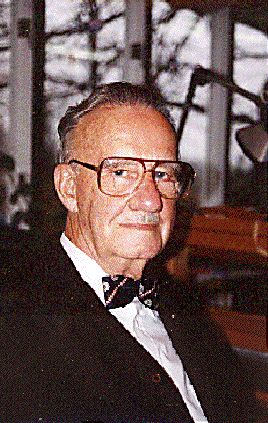
Dr. Wilson Greatbatch, the inventor of the implantable pacemaker.
Dr. Wilson Greatbatch is still on duty -- The implantable
pacemaker helps millions of people around the world

Dr. Wilson Greatbatch, the inventor of the implantable pacemaker.
Clarence/Buffalo. One of the most successful inventors of the 20th century has his 75th birthday on September 6, 1994: Dr. Wilson Greatbatch, the inventor of the implantable pacemaker.
Uncounted millions of people all over the world are getting help from this invention of 1958. This instrument which gives electric impulses to weak hearts helps many sick people lead better and more productive comfortable lives than a heart-transplant could do.
Compared with Prof. Christian Barnard of South Africa, who was successful with the first heart-transplant on December 3, 1967, the inventor Wilson Greatbatch is not as well known to the public as Barnard is. Greatbatch belongs to the "silent scientists and inventors." This brought him greatest success. He has more thank 150 patents on different inventions.
Mr. Greatbatch received many international awards. On the occasion of his 75th birthday he became a member of the international Order of Alexander the Great for Science and Art (Paris). He follows in this honorable Order on the seat of the late Leonard Bernstein. Other members of this society are Ronald Reagan, the Prince of Wales, Sir Peter Ustinov, Felipe, the Crown Prince of Spain, George Bush, and Dr. Uta Ranke-Heinemann, professor of catholic theology.
Greatbatch continues working every day. "There is still a lot to discover for the benefit of mankind," he says in his laboratory in Clarence, New York. New subjects for him are Aids and Ecology.
Wilson Greatbatch was born in 1919 in Buffalo. Already as a young boy he showed high interest in technical developments. Later, as an engineer he worked on medical-technical instruments. The technical possibility to give new strength to a weak heart through electrical impulses has kept him occupied day and night, recalls Greatbatch. It was in an old barn where he began with the construction of the pacemaker. There were no vacations for him. With his wife Eleanor and five children he has led a modest life.
The inventing of the pacemaker was a highly complicated matter. "Back then I had to solve the problem how to reduce an electronic apparatus in the size of a kitchen cabinet to the size of a baby's hand, in order to be able to be able to implant this pacemaker into the chest," reports Greatbatch.
On May 7, 1958 his scientific team accomplished the pioneering breakthrough. In a painless animal experiment a pacemaker was implanted into a dog. In October of the same year, his friend Dr. Ake Senning in Stockholm, Sweden attempted an implant in a human. "It was not successful. It worked only three hours," said Greatbatch. "It failed and was then replaced by another which worked only eight days."
The breakthrough came to Greatbatch on April 15, 1960. The team of surgeons led by Dr. William Chardack, Dr. Andrew Gage and Dr. Sanford at Millard Fillmore Hospital in Buffalo, New York implanted the first full-working pacemaker into the 77 year old Henry Hennafeld "This first in the world clinically successful implanted unit worked for 18 months without problems," Greatbatch says.
At the age of 40 years Greatbatch filed his first pacemaker patent on July 22, 1960. It is registered in the U.S. Patent Office under No. 3,057,356. On this invention all subsequent improvements in pacemakers in the world are based, up to this very day. Most of the pacemakers are implanted in the United States and Europe. Prominent people like the former German Chancellor Helmut Schmidt and the German Foreign Minister Hans-Dietrich Genscher have had pacemakers for many years. But most prominent people do not like to talk about the fact that they get help from a pacemaker.
Copyright 1996 PROMETHEUS
Arno Breker: His Art and Life, by B. John Zavrel
Collected Writings of Arno Breker, by Arno Breker
Living with the Himalayan Masters, by Swami Rama
Alexander the Great, by Robin Lane Fox
Primer for Those Who Would Govern, by Hermann Oberth